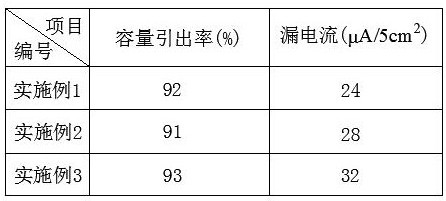Manufacturing method of low-voltage formed foil for solid aluminum electrolytic capacitor
A technology of aluminum electrolytic capacitors and manufacturing methods, which is applied in the manufacture of electrolytic capacitors, solid electrolytic capacitors, electrolytic capacitors, etc., can solve the problems of inability to meet solid aluminum electrolytic capacitors, low capacity extraction rate of capacitors, large oxide film gap, etc. The effect of capacity extraction rate, uniform voltage distribution and dense oxide film
- Summary
- Abstract
- Description
- Claims
- Application Information
AI Technical Summary
Problems solved by technology
Method used
Image
Examples
Embodiment 1
[0029] a) The corroded foil was placed in a 10 wt% ammonium adipate solution at a temperature of 90 °C and a current density of 200 mA / cm 2 , Under the condition of a voltage of 5 V, anodized for 10 min to obtain a primary formed foil;
[0030] b) Put the primary formed foil in a 10 wt% ammonium adipate solution at a temperature of 90°C and a current density of 200mA / cm 2 1. Under the condition of a voltage of 10 V, anodized for 10 minutes to obtain a secondary formed foil;
[0031] c) Place the secondary formed foil in a 10 wt% ammonium adipate solution at a temperature of 90°C and a current density of 200mA / cm 2 , Under the condition of a voltage of 15 V, anodized for 10 min to obtain a tertiary formed foil;
[0032] d) Place the tertiary formed foil in a 10 wt% ammonium adipate solution at a temperature of 90°C and a current density of 200mA / cm 2 , Under the condition of a voltage of 20 V, anodized for 10 minutes to obtain a four-stage formed foil;
[0033] e) Place the...
Embodiment 2
[0041] a) The corroded foil was placed in a 15 wt% ammonium adipate solution at a temperature of 85 °C and a current density of 150 mA / cm 2 1. Under the condition of a voltage of 10 V, anodized for 12 minutes to obtain a primary formed foil;
[0042] b) Put the primary formed foil in a 15 wt% ammonium adipate solution at a temperature of 85°C and a current density of 150mA / cm 2 , Under the condition of a voltage of 20 V, anodized for 12 minutes to obtain a secondary formed foil;
[0043] c) Place the secondary formed foil in a 15 wt% ammonium adipate solution at a temperature of 85°C and a current density of 150mA / cm 2 , Under the condition of a voltage of 30 V, anodized for 12 minutes to obtain a tertiary formed foil;
[0044] d) Place the tertiary formed foil in a 15 wt% ammonium adipate solution at a temperature of 85°C and a current density of 150mA / cm 2 , Under the condition of voltage 40 V, anodized for 10 min to obtain four-stage formed foil;
[0045] e) Place the q...
Embodiment 3
[0053] a) The corroded foil was placed in a 20 wt% ammonium adipate solution at a temperature of 80 °C and a current density of 100 mA / cm 2 1. Under the condition of a voltage of 20 V, anodized for 15 minutes to obtain a primary formed foil;
[0054] b) Put the primary formed foil in a 20 wt% ammonium adipate solution at a temperature of 80°C and a current density of 100mA / cm 2 1. Under the condition of voltage of 40 V, anodized for 15 minutes to obtain secondary formed foil;
[0055] c) Place the secondary formed foil in a 20 wt% ammonium adipate solution at a temperature of 80°C and a current density of 100mA / cm 2 1. Under the condition of voltage 60V, anodize for 15 minutes to obtain three-stage formed foil;
[0056] d) Place the tertiary formed foil in a 15 wt% ammonium adipate solution at a temperature of 80°C and a current density of 100mA / cm 2 , Under the condition of a voltage of 80 V, anodized for 15 minutes to obtain a four-stage formed foil;
[0057] e) Place th...
PUM
 Login to View More
Login to View More Abstract
Description
Claims
Application Information
 Login to View More
Login to View More - R&D
- Intellectual Property
- Life Sciences
- Materials
- Tech Scout
- Unparalleled Data Quality
- Higher Quality Content
- 60% Fewer Hallucinations
Browse by: Latest US Patents, China's latest patents, Technical Efficacy Thesaurus, Application Domain, Technology Topic, Popular Technical Reports.
© 2025 PatSnap. All rights reserved.Legal|Privacy policy|Modern Slavery Act Transparency Statement|Sitemap|About US| Contact US: help@patsnap.com

